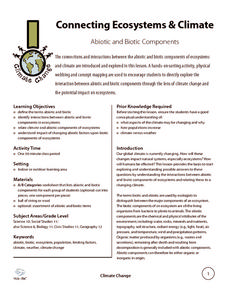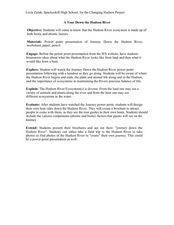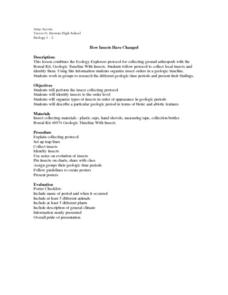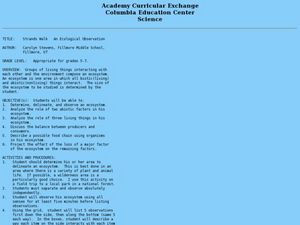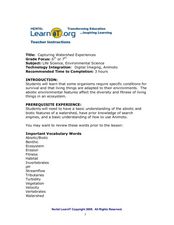Curated OER
The Marvels of Mud
Young scientists roll up their sleeves and get a little dirty in this three-day earth science investigation. Following the scientific method, children monitor the growth of algae in pond water samples in order to determine...
Kentucky School for the Deaf
Levels of Organization within an Ecosystem
From tiny organisms to entire biomes, young scientists examine the interdependent relationships tying all living and non-living things together with this collection of ecology resources.
National Wildlife Federation
Habitat Web
Young scientists weave together an understanding of ecosystems with this fun collaborative activity. Taking on the roles of different living and non-living elements of specific habitats, learners use a ball of yarn to create...
National Park Service
Living & Non-Living Interactions
What better way to learn about ecosystems than by getting outside and observing them first hand? Accompanying a field trip to a local park or outdoor space, this series of collaborative activities engages children in...
Wild BC
Connecting Ecosystems & Climate
Collaborators sort a set of cards into biotic and abiotic categories. Then, as a class, they discuss their work and relate each of the abiotic components to climate change. Finally, they form a web of components by connecting those that...
Curated OER
That's Predictable - Stream Side Science
Research the impact that changes in biotic or abiotic factors might have on an ecosystem. Debate for or against the changes and take action in the community. This resource ideally follows stream studies that young ecologists may have...
Random House
Recipe for an Ecosystem
Creating an ecosystem is as simple as baking a cake. Well, maybe not, but using a recipe analogy helps learners realize that ecosystems consist of different components that come together in unique ways. Offer this worksheet as an...
Curated OER
Sample Midyear Examination (Chemistry and Biology)
A 12-page midterm exam sample can be given to young scientists in preparation for an exam. This particular installment is geared toward a class that delves into both ecology and chemistry concepts. There is no way to separate the 50...
Curated OER
A Tour Down the Hudson River
Students discuss how the Hudson River is an ecosystem made up of both biotic and abiotic factors. They view the PowerPoint the Journal Down the Hudson River. Students become aware of where the Hudson River begins and ends, the plant and...
Curated OER
Ecology
For use early in the year with your ecology class, this collection of slides introduces viewers to cycles in nature and relationships between organisms. There is a food web diagram, but the presentation is incomplete without any diagrams...
Curated OER
How Insects Have Changed
Students work in groups to research the different geologic time periods and present their findings. They perform the insect collecting protocol, identify insects to the order level, and organize types of insects in order of appearance in...
Curated OER
Bahamian Terrariums
Sixth graders create a Bahamian terrarium. In this Bahamian ecosystem lesson plan, 6th graders watch a PowerPoint to see Bahamian biotic and abiotic factors. They bring in 2-3 items for their terrarium.
Curated OER
Biodiversity and Ecosystems
Middle schoolers differentiate between biotic and abiotic factors in this science lesson plan. Learners collect data for the experiment and analyze the data after graphing it using the CBL 2. This experiment is split into two different...
Curated OER
Strands Walk-An Ecological Obseravtion
In this ecosystem worksheet, students investigate an ecosystem at a local park or national forest, they make observations for five minutes, they complete a grid of their observations and they construct a hypothetical food chain. Students...
Curated OER
Capturing Watershed Experiences
Students observe organisms found in the water. In this instructional activity on organisms, students collect water from local streams and tributaries in order to study the organisms found in the water. As a culminating activity, students...
Curated OER
Counting Animal Populations
Students learn how to count animal populations by the Mark and Recapture method. In this counting animal populations lesson plan, students begin by predicting amounts of different candies in a jar. Students then simulate using beans, two...
Curated OER
Water Conditions
Young scholars investigate the importance of water in an environment with living things. in this water conditions lesson plan, students soak radish sees in water, vinegar, soap and alcohol. Young scholars remove the seeds, store them for...
Curated OER
Ecosystems at School
In this ecosystem worksheet, learners use a string and make a large circle. Everything in the circle is part of the ecosystem the students will study. They identify everything in their ecosystem and classify their data. They answer 2...
Curated OER
Succession in a Jar
In this succession worksheet, students build an ecosystem using a jar, water, bird seed, soil and a water plant. They predict what their ecosystem will look like in 3 weeks and draw a diagram. Students record their data over the course...
Curated OER
Communities and Biomes
In this biomes worksheet, students complete a crossword puzzle by figuring out the answers to 17 clues focused on communities and biomes.
Curated OER
The Language of Science
In this language of science worksheet, learners use the list provided to guess the meaning of each of the list. Students apply root words, prefixes, and suffixes to gain meaning of other science words.
Curated OER
Communities and Biomes
In this communities worksheet, students will look at the interactions between biotic and abiotic factors and the effect these factors have on organism populations. Students will also order the succession steps that occur over time in an...
Curated OER
Living and Nonliving Environments
In this ecosystem worksheet, students will distinguish between the abiotic factors and biotic factors shown in a diagram. Then students will correctly order the following: population, ecosystem, community, and organism.
Curated OER
Biotic and Abiotic Factors
In this biotic and abiotic factors worksheet, students complete 20 various types of questions related to biotic and abiotic factors. First, they write the vocabulary word that best completes the sentence. Then, students state an example...






